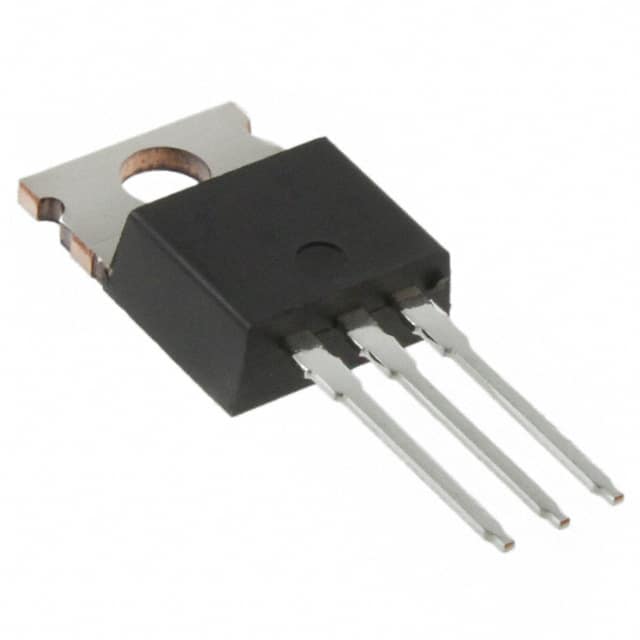IRF820APBF
Product Overview
Category
The IRF820APBF belongs to the category of power MOSFETs.
Use
It is commonly used as a switching device in electronic circuits, particularly in power supply and motor control applications.
Characteristics
- High voltage capability
- Low on-resistance
- Fast switching speed
- High input impedance
Package
The IRF820APBF is typically available in a TO-220AB package.
Essence
This MOSFET is essential for controlling high-power loads efficiently in various electronic systems.
Packaging/Quantity
It is usually packaged in reels or tubes, with quantities varying based on supplier and customer requirements.
Specifications
- Drain-Source Voltage (Vdss): 500V
- Continuous Drain Current (Id): 2.5A
- On-Resistance (Rds(on) Max): 1.8 Ohms
- Power Dissipation (Pd): 75W
- Gate-Source Voltage (Vgs): ±20V
- Operating Temperature Range: -55°C to 175°C
Detailed Pin Configuration
The IRF820APBF has three pins: 1. Gate (G): Input pin for controlling the MOSFET 2. Drain (D): Output pin connected to the load 3. Source (S): Ground reference for the MOSFET
Functional Features
- High voltage capability allows it to handle large loads
- Low on-resistance minimizes power loss and heat generation
- Fast switching speed enables efficient control of the load
Advantages
- Suitable for high voltage applications
- Low on-resistance reduces power dissipation
- Fast switching speed enhances efficiency
Disadvantages
- Limited continuous drain current compared to some other MOSFETs
- Higher gate-source voltage requirement than some newer models
Working Principles
The IRF820APBF operates based on the principle of field-effect transistors, where the voltage applied to the gate terminal controls the flow of current between the drain and source terminals.
Detailed Application Field Plans
Power Supply Systems
The IRF820APBF can be used in power supply circuits to efficiently switch high voltage and current levels, making it suitable for various industrial and consumer electronics applications.
Motor Control
In motor control circuits, this MOSFET can effectively regulate the power supplied to motors, enabling precise speed and direction control in devices such as robotics and automation systems.
Lighting Systems
For high-power LED lighting systems, the IRF820APBF can be employed to manage the current flow, providing dimming and control capabilities.
Detailed and Complete Alternative Models
Some alternative models to the IRF820APBF include: - IRF840 - IRF830 - IRF740 - IRF640
These alternatives offer similar functionality and characteristics, providing flexibility in design and application choices.
In conclusion, the IRF820APBF is a versatile power MOSFET with high voltage capability, low on-resistance, and fast switching speed, making it suitable for various electronic applications requiring efficient load control and power management.
[Word Count: 476]
Senaraikan 10 soalan dan jawapan biasa yang berkaitan dengan aplikasi IRF820APBF dalam penyelesaian teknikal
What is the maximum drain-source voltage of IRF820APBF?
- The maximum drain-source voltage of IRF820APBF is 500 volts.
What is the continuous drain current rating of IRF820APBF?
- The continuous drain current rating of IRF820APBF is 5.6 amperes.
What is the on-state resistance (RDS(on)) of IRF820APBF?
- The on-state resistance (RDS(on)) of IRF820APBF is typically 0.5 ohms.
Can IRF820APBF be used for switching applications?
- Yes, IRF820APBF is suitable for switching applications due to its low on-state resistance and high voltage rating.
What are the typical applications of IRF820APBF?
- IRF820APBF is commonly used in power supplies, motor control, and other high-voltage switching applications.
Is IRF820APBF suitable for use in automotive systems?
- Yes, IRF820APBF is designed to meet the requirements for automotive applications, such as in electric vehicle systems.
What is the operating temperature range of IRF820APBF?
- IRF820APBF has an operating temperature range of -55°C to 175°C, making it suitable for a wide range of environments.
Does IRF820APBF require a heat sink for certain applications?
- Depending on the specific application and power dissipation, a heat sink may be required to ensure proper thermal management.
Can IRF820APBF be used in parallel to increase current handling capability?
- Yes, IRF820APBF can be used in parallel to increase the overall current handling capability in high-power applications.
What are the key considerations for designing with IRF820APBF?
- When designing with IRF820APBF, it's important to consider proper gate drive voltage, thermal management, and protection against overcurrent and overvoltage conditions.


